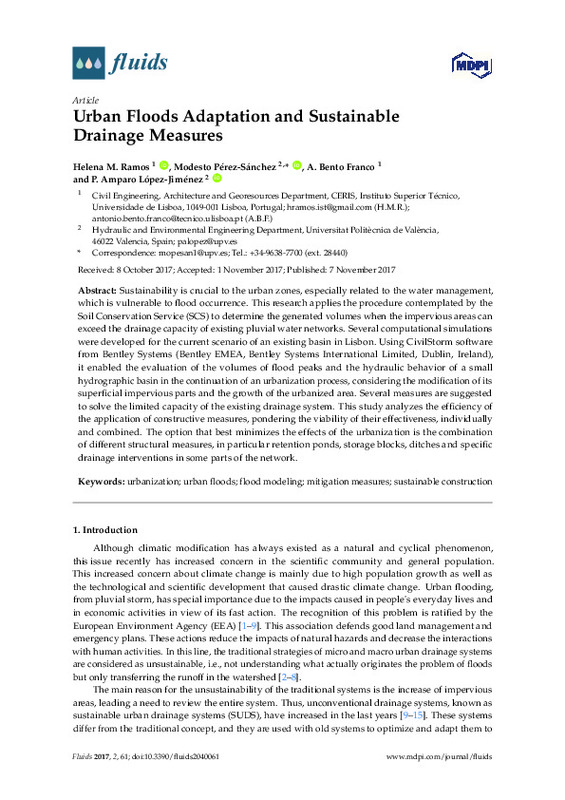JavaScript is disabled for your browser. Some features of this site may not work without it.
Buscar en RiuNet
Listar
Mi cuenta
Estadísticas
Ayuda RiuNet
Admin. UPV
Urban Floods Adaptation and Sustainable Drainage Measures
Mostrar el registro sencillo del ítem
Ficheros en el ítem
| dc.contributor.author | Ramos, Helena M.
|
es_ES |
| dc.contributor.author | Pérez-Sánchez, Modesto
|
es_ES |
| dc.contributor.author | Bento Franco, A.
|
es_ES |
| dc.contributor.author | López Jiménez, Petra Amparo
|
es_ES |
| dc.date.accessioned | 2018-03-12T05:12:31Z | |
| dc.date.available | 2018-03-12T05:12:31Z | |
| dc.date.issued | 2017 | es_ES |
| dc.identifier.uri | http://hdl.handle.net/10251/99169 | |
| dc.description.abstract | [EN] Sustainability is crucial to the urban zones, especially related to the water management, which is vulnerable to flood occurrence. This research applies the procedure contemplated by the Soil Conservation Service (SCS) to determine the generated volumes when the impervious areas can exceed the drainage capacity of existing pluvial water networks. Several computational simulations were developed for the current scenario of an existing basin in Lisbon. Using CivilStorm software from Bentley Systems (Bentley EMEA, Bentley Systems International Limited, Dublin, Ireland), it enabled the evaluation of the volumes of flood peaks and the hydraulic behavior of a small hydrographic basin in the continuation of an urbanization process, considering the modification of its superficial impervious parts and the growth of the urbanized area. Several measures are suggested to solve the limited capacity of the existing drainage system. This study analyzes the efficiency of the application of constructive measures, pondering the viability of their effectiveness, individually and combined. The option that best minimizes the effects of the urbanization is the combination of different structural measures, in particular retention ponds, storage blocks, ditches and specific drainage interventions in some parts of the network. | es_ES |
| dc.description.sponsorship | The authors want to thank the project REDAWN (Reducing Energy Dependency in Atlantic Area Water Networks) EAPA_198/2016 from INTERREG ATLANTIC AREA PROGRAMME 2014-2020 and CERIS (CEHIDRO-IST). The authors also thank the program to support the academic career at the faculty of the Universitat Politecnica de Valencia 2016/2017 in the project "Maximization of the global efficiency in PATs (Pumps as Turbines) in laboratory facility" of the Modesto Perez-Sanchez. | en_EN |
| dc.language | Inglés | es_ES |
| dc.publisher | MDPI AG | es_ES |
| dc.relation.ispartof | Fluids | es_ES |
| dc.rights | Reconocimiento (by) | es_ES |
| dc.subject | Urbanization | es_ES |
| dc.subject | Urban floods | es_ES |
| dc.subject | Flood modeling | es_ES |
| dc.subject | Mitigation measures | es_ES |
| dc.subject | Sustainable construction | es_ES |
| dc.subject.classification | INGENIERIA HIDRAULICA | es_ES |
| dc.subject.classification | MECANICA DE FLUIDOS | es_ES |
| dc.title | Urban Floods Adaptation and Sustainable Drainage Measures | es_ES |
| dc.type | Artículo | es_ES |
| dc.identifier.doi | 10.3390/fluids2040061 | es_ES |
| dc.relation.projectID | info:eu-repo/grantAgreement/FEDER//ATLANTIC-EAPA_198/2016/EU/Reducing energy dependency in atlantic area water networks/REDAWN/ | es_ES |
| dc.rights.accessRights | Abierto | es_ES |
| dc.contributor.affiliation | Universitat Politècnica de València. Departamento de Ingeniería Hidráulica y Medio Ambiente - Departament d'Enginyeria Hidràulica i Medi Ambient | es_ES |
| dc.description.bibliographicCitation | Ramos, HM.; Pérez-Sánchez, M.; Bento Franco, A.; López Jiménez, PA. (2017). Urban Floods Adaptation and Sustainable Drainage Measures. Fluids. 2(4):1-18. doi:10.3390/fluids2040061 | es_ES |
| dc.description.accrualMethod | S | es_ES |
| dc.relation.publisherversion | https://doi.org/10.3390/fluids2040061 | es_ES |
| dc.description.upvformatpinicio | 1 | es_ES |
| dc.description.upvformatpfin | 18 | es_ES |
| dc.type.version | info:eu-repo/semantics/publishedVersion | es_ES |
| dc.description.volume | 2 | es_ES |
| dc.description.issue | 4 | es_ES |
| dc.identifier.eissn | 2311-5521 | es_ES |
| dc.relation.pasarela | S\345822 | es_ES |
| dc.contributor.funder | European Regional Development Fund | |
| dc.description.references | Neal, J., Villanueva, I., Wright, N., Willis, T., Fewtrell, T., & Bates, P. (2011). How much physical complexity is needed to model flood inundation? Hydrological Processes, 26(15), 2264-2282. doi:10.1002/hyp.8339 | es_ES |
| dc.description.references | Miller, J. D., & Hutchins, M. (2017). The impacts of urbanisation and climate change on urban flooding and urban water quality: A review of the evidence concerning the United Kingdom. Journal of Hydrology: Regional Studies, 12, 345-362. doi:10.1016/j.ejrh.2017.06.006 | es_ES |
| dc.description.references | Costabile, P., Costanzo, C., & Macchione, F. (2017). Performances and limitations of the diffusive approximation of the 2-d shallow water equations for flood simulation in urban and rural areas. Applied Numerical Mathematics, 116, 141-156. doi:10.1016/j.apnum.2016.07.003 | es_ES |
| dc.description.references | Ashley, R. M., Balmforth, D. J., Saul, A. J., & Blanskby, J. D. (2005). Flooding in the future – predicting climate change, risks and responses in urban areas. Water Science and Technology, 52(5), 265-273. doi:10.2166/wst.2005.0142 | es_ES |
| dc.description.references | Fowler, H. J., & Wilby, R. L. (2010). Detecting changes in seasonal precipitation extremes using regional climate model projections: Implications for managing fluvial flood risk. Water Resources Research, 46(3). doi:10.1029/2008wr007636 | es_ES |
| dc.description.references | Jacobson, C. R. (2011). Identification and quantification of the hydrological impacts of imperviousness in urban catchments: A review. Journal of Environmental Management, 92(6), 1438-1448. doi:10.1016/j.jenvman.2011.01.018 | es_ES |
| dc.description.references | Perales-Momparler, S., Hernández-Crespo, C., Vallés-Morán, F., Martín, M., Andrés-Doménech, I., Andreu Álvarez, J., & Jefferies, C. (2013). SuDS Efficiency during the Start-Up Period under Mediterranean Climatic Conditions. CLEAN - Soil, Air, Water, 42(2), 178-186. doi:10.1002/clen.201300164 | es_ES |
| dc.description.references | Hutchins, M. G., McGrane, S. J., Miller, J. D., Hagen-Zanker, A., Kjeldsen, T. R., Dadson, S. J., & Rowland, C. S. (2016). Integrated modeling in urban hydrology: reviewing the role of monitoring technology in overcoming the issue of ‘big data’ requirements. Wiley Interdisciplinary Reviews: Water, 4(1), e1177. doi:10.1002/wat2.1177 | es_ES |
| dc.description.references | Geldof, G. D. (1995). Adaptive water management: integrated water management on the edge of chaos. Water Science and Technology, 32(1), 7-13. doi:10.2166/wst.1995.0004 | es_ES |
| dc.description.references | CivilStorm® Comprehensive Stormwater Modeling and Analysishttps://www.bentley.com/pt/products/product-line/hydraulics-and-hydrology-software/civilstorm | es_ES |








